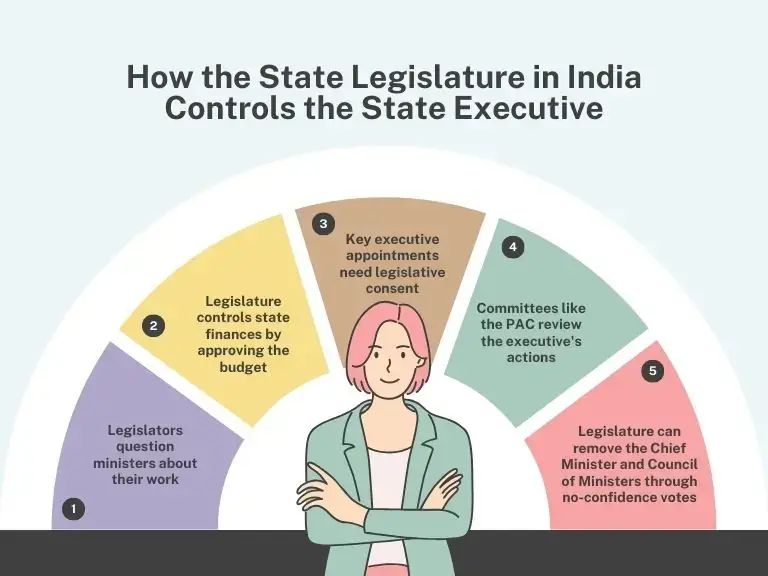In India, the State Legislature keeps control over the State Executive through several key mechanisms. These mechanisms ensure that the executive branch operates within the bounds of the law and is accountable to the elected representatives of the people.
The State Executive, headed by the Governor and including the Chief Minister and the Council of Ministers, is responsible for implementing laws and running the day-to-day affairs of the state.

However, to prevent the misuse of power and ensure accountability, the State Legislature monitors and regulates the executive’s activities. This oversight ensures that the executive remains answerable to the elected representatives and, by extension, to the citizens. Here’s how it works:
Legislative Oversight
The State Legislature keeps a check on the actions of the State Executive by:
- Question Hour: Members of the legislature ask questions to ministers about their work, which they must answer.
- Debates and Discussions: Issues related to the executive’s policies and actions are debated, providing a platform for accountability.
Budget Control
The State Legislature controls the finances of the state:
- Passing the Budget: The budget, which outlines how the state’s money will be spent, must be approved by the legislature. This gives them control over the funds used by the executive branch.
- Cut Motions: Legislators can propose cuts to specific budget items if they believe money is being wasted.
Approval of Appointments
Certain appointments made by the State Executive need the approval of the State Legislature:
- Legislative Approval: Key positions, such as the Advocate General or certain members of commissions, require legislative consent.
Legislative Inquiries and Committees
The State Legislature has the power to investigate the actions of the State Executive:
- Committees: Various committees, such as Public Accounts Committee (PAC) and Estimates Committee, scrutinize the executive’s actions and financial management.
- Inquiries: The legislature can set up inquiries to investigate issues or misconduct in the executive branch.
Impeachment and No-Confidence Motions
The State Legislature can remove key executive officials if necessary:
- No-Confidence Motion: The legislature can pass a no-confidence motion against the Chief Minister or the Council of Ministers. If passed, the Chief Minister and the council must resign.
- Impeachment: High officials like the Governor can be impeached for misconduct.
Making and Amending Laws
The State Legislature makes laws that guide the functioning of the State Executive:
- Law Making: The legislature passes laws that the executive must implement.
- Amendments: They can change laws to correct or improve the functioning of the executive.
Auditing and Reports
Independent agencies report to the State Legislature:
- Comptroller and Auditor General (CAG): The CAG audits the accounts of the state and reports any issues to the legislature.
- Reports: Various reports from commissions and committees provide the legislature with information on executive actions.
These mechanisms ensure that the State Executive remains accountable to the State Legislature and operates within the framework of the law. This system of checks and balances helps maintain a fair and transparent government in India.



